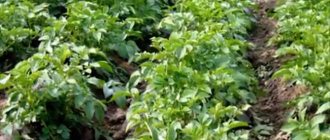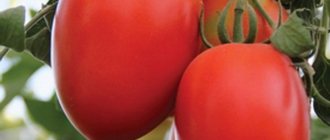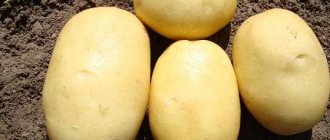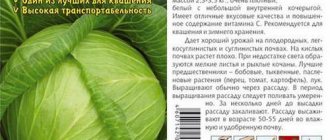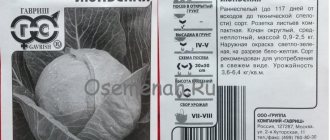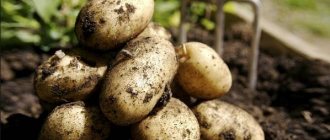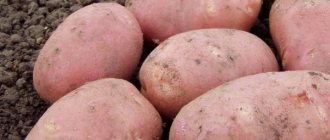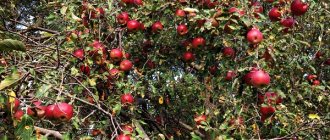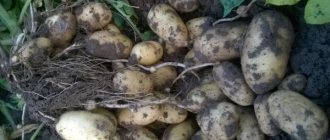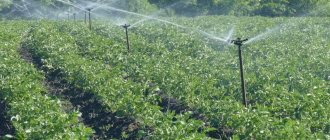Potatoes Rogneda: variety description
| Variety name | Rogneda |
| general characteristics | mid-late table variety of Belarusian selection; adapts well to conditions and soil |
| Maturation period | 95-110 days |
| Starch content | 12,7-18,4% |
| Weight of marketable tubers | 78-120 gr |
| Number of tubers in a bush | 12-14 |
| Productivity | 187-353 (maximum – 431) c/ha |
| Consumer qualities | good and excellent taste, suitable for preparing any dishes |
| Keeping quality | 97% |
| Peel color | yellow |
| Flesh color | cream |
| Preferred Growing Regions | Northwestern |
| Disease resistance | the variety is resistant to the causative agent of potato cancer, golden potato cyst nematode, wrinkled and striped mosaic |
| Features of cultivation | standard agricultural technology |
| Originator | Republican Unitary Enterprise Scientific and Practical Center of the National Academy of Sciences of Belarus for potato and fruit and vegetable growing |
“Rogneda” is a medium-late variety; on average, 115–120 days pass from the appearance of the main shoots to technical maturity.
The technical maturity of potatoes means that the tubers are suitable for storage and have a dense skin (although tubers of conditional maturity - with thin, lagging skin - can also be eaten).
The bush is large, tall, semi-erect. It has leaves of an intermediate type, typical in shape for potatoes, wrinkled in structure, without pubescence, and slightly wavy along the edges. The leaf size is medium, the color is light green (green). It has a medium-sized flower corolla, the color is white (low content of anthocyanins - substances that determine color).
Root description:
- The peel is pale yellow (sand), dense, smooth.
- The eyes are small and of medium depth.
- The color of the pulp is cream.
- Shape - oval, rounded - oblong.
- The starch content varies according to table varieties - from 13% to 19%.
- Weight - from 80 g to 120 g.
Harvest and storage
In order for the grown crop to please you for a long time, it is important to harvest it correctly and on time.
How and when to collect
Technical maturity of tubers occurs at 95-110 days. The tops begin to turn yellow and dry out. This period falls in mid-September. The tops are pre-mowed. When harvesting, avoid mechanical damage to the tubers. Potatoes collected from the garden are dried and sorted.
Storage features and keeping quality of the variety
The harvested crop is stored in a dark place at a temperature not exceeding +5°C and air humidity of 80%. Subject to storage conditions, potatoes retain their quality until May.
Climate zones
Favorable zones for cultivation are the North-West and Central regions of the Russian Federation. They are grown throughout Russia and in other countries - Ukraine, Moldova, taking into account the variety of growing technologies.
Reference. In different regions, different varieties of potatoes are planted, developed for a specific zone; different planting depths, different amounts of irrigation, and fertilizing are required.
Peculiarities
Characteristic properties of the variety:
- Grows on any soil, but maximizes its potential on light soils (sand, sandy loam). In heavy soil, root crops often rot and develop poorly.
- It is advisable to plant “Rogneda” on virgin soil or on a “rested” area. In this case, the tops develop rapidly, and the tubers gain weight without additional feeding.
- Planting tomatoes on the ground has a bad effect on the growing season of potatoes. The green parts of plants suffer from fungal diseases.
- The variety requires sufficient, but not excessive, attention: the plants need to be hilled and fed twice a season, the soil should be loosened regularly and watered periodically.
Productivity and methods of use
The productivity of "Rogneda" is quite high, about 300 quintals per 1 hectare, which corresponds to the established standard; under favorable conditions and proper care, the figures increase to 450 quintals and higher per 1 hectare (75 tons per 1 hectare).
“Rogneda” is a table variety, intended for consumption after heat treatment, and there are a great many recipes for potato dishes. The beneficial substances will be preserved in full when potatoes are cooked in their skins (“in their jackets”).
Only root vegetables with a dense (hard) consistency can be eaten; wrinkled tubers are suitable for eating, but will not bring any benefit. Read more about the properties of potatoes: why solanine is dangerous and juice is beneficial, what are the benefits and harms of sprouts, and what are raw potatoes used for.
Planting and caring for Ragneda potatoes
Ragneda potatoes are planted in the second half of May, the timing is coordinated with the climate. If the soil has warmed up to +160 C, planting work can begin.
Selection and preparation of a landing site
Ragneda potatoes are unpretentious to soil composition and produce a stable harvest on any soil, except lowlands and wetlands. The fruiting rate increases if the composition is fertile; preference is given to light sandy loam soil.
Attention! For photosynthesis, the Ragneda variety needs a sufficient amount of ultraviolet radiation; in the shade, the growing season slows down and the fruits become smaller.
The site has been prepared since the fall. Remove the remains of old tops and weed roots. They dig up the soil and add organic matter. In the spring, 14 days before planting the seeds, the area is dug up again and saltpeter is scattered.
Preparation of planting material
To speed up the growing season of the plant, the mid-late variety Ragneda is bred with sprouted seeds. You can purchase them or prepare them yourself. Potatoes are selected in the fall after harvest or in the spring. Take medium-sized seeds, weighing 60 g.
Planting material, prepared in boxes in the fall, is taken out for germination. In the spring, you can select the seeds and put them in a container or spread them in a thin layer on a flat surface. Seeds are prepared approximately at the end of March. Ragneda potatoes are sprouted in good light and a temperature of +80 C. Sprouts for planting should grow no more than 2.5 cm.
Landing rules
Ragneda potatoes are planted in single holes or furrows, the planting pattern is the same. The depth of the hole is 16 cm, the row spacing is 50 cm, the distance between the bushes is 35 cm. Two tubers are placed in one planting hole at a distance of 7 cm. The top is covered with a mixture of peat and ash in equal proportions, then with soil.
Watering and fertilizing
With the condition of single precipitation per month, Ragned potatoes are not additionally watered. If the summer is dry, one intensive watering is enough after 3 weeks after flowering. Fertilizing is applied in the spring a month after planting the seeds, fertilized with phosphate, potassium agents, and urea. Nitrogen-containing fertilizers are applied at the time of flowering.
Loosening and weeding
Ragneda potatoes will produce young shoots 15 days after planting the seeds. When the crop has grown enough to define rows, the first weeding is carried out. When the variety grows to 15 cm, repeated loosening is necessary to remove weeds and ensure unhindered access of oxygen to the root system. Cut weeds and roots are removed from the garden bed.
Hilling
Ragneda potatoes are hilled up when the tops grow to 25 cm. If planting was done in holes, soil is poured on all sides, up to the top leaves. When placing seeds in furrows, make a continuous mound on both sides in the form of a ridge. After 2.5 weeks the procedure is repeated:
- the embankment is trimmed;
- loosen the top layer;
- remove remaining weeds.
Photo
The photo shows the Rogneda potato variety
Growing
In order for the yield to be high, it is important to adhere to basic recommendations for cultivation and care. Potatoes are planted in an open area, not deprived of sunlight.
Light to medium soils are ideal; heavy soils can impair yields.
In the fall, the site is dug up and fertilized. It is best to use organic matter or wood ash. In the spring, the beds are dug up again, after which complex fertilizers or rotted manure are added.
Planting potatoes are selected in the fall, immediately after harvesting.
It is important to choose high-quality root vegetables that will produce powerful shoots. It is recommended to germinate the tubers before planting
To do this, root vegetables are placed in special boxes or boxes, where the air temperature is about 8 degrees. It is recommended to turn the potatoes periodically.
Rogneda is planted under favorable weather conditions. The soil should warm up to 8 degrees
When disembarking, it is important to consider the following recommendations:
- make deep enough holes;
- the holes should be at least 35 cm apart from each other, since Rogneda is characterized by spreading bushes;
- Dense planting of tubers reduces yield.
Advantages and disadvantages
It has no disadvantages; some negative qualities are possible in the form of small root crops, the presence of a large amount of liquid in potatoes, under unfavorable weather conditions and improper care.
Advantages :
- excellent taste;
- high content of vitamin C;
- abundant harvest of large potatoes;
- marketable condition;
- long storage;
- well resistant to most diseases and drought;
- has resistance to mechanical damage;
- not picky about soil type.
The variety was bred by breeders from Belarus. The originator is the Republican Unitary Enterprise “Scientific and Practical Center of the National Academy of Sciences of Belarus for Potato and Fruit and Vegetable Growing.” Included in the State Register of the Russian Federation for the North-Western region in 2011.
Reviews
Reviews about this variety are most often positive; gardeners recommend it for cultivation.
Mikhail, Sortavala : “For many years I have been growing potatoes on my summer cottage. Including the Ragneda variety. But there is one soreness that does not spare any variety. This is late blight. It is known that it will not exist on soils rich in copper. Here's how I fight late blight: before planting, I treat the tubers with copper sulfate. And when the tops appear, I spray them too.”
Vasily, Vologda: “ When, on the advice of a friend, I tried to grow Ragneda, I was pleasantly surprised: the variety is resistant to our weather conditions and pests, and produces a decent harvest. I would recommend it even to beginning gardeners.”
Marina, Lodeynoye Pole: “I found a description of the variety and a photo of the Ragneda potato on the Internet, and started growing it 4 years ago. The variety is high-yielding, I take about 2.5 kg from one bush. It has other advantages too. First of all, taste. The tubers are well preserved in the cellar almost until the next harvest.”
Characteristics of the variety and cultivation characteristics
Seed potatoes for planting are usually taken from last year's harvest or purchased in stores. Rogneda potatoes are planted in May in any type of soil to a depth of about 7 cm with a distance between plants of 20 cm, sometimes less or more, depending on the region.
Also, according to the advice of experienced gardeners, “Rogneda” should be planted less often than other varieties due to its well-developed numerous root crops. Planting method: in furrows or in individual holes in open ground.
Important! In areas with high humidity, planting on an elevated surface (in beds) is necessary.
Potatoes respond well to rested soil (where mustard or rye, other perennial or annual plants, grain and legumes were sown for a year or two) or to new plowed areas.
Important! It makes no sense to plant potatoes on undisinfected areas of soil where tomatoes grew last year or in the vicinity of nightshades - these plants have a number of the same diseases.
“Rogneda” should be loosened and hilled several times a season, fertilized with mineral fertilizers, and weeded as necessary. In dry summers, some watering is necessary, infrequently and not abundantly, the variety is drought-resistant.
Read more about agrotechnical techniques used when growing potatoes: is hilling necessary, what technical devices are best to do it, how to do it manually and with a walk-behind tractor. And also, is it possible to get a good harvest without weeding and hilling, why are fertilizers needed, which of them are the best, what should you feed the plantings with, when and how to apply it, how to do it correctly when planting.
The variety is multi-tuberous (from 10 pieces), intensively develops tubers, ensuring a good harvest. Shooting and growth of tops is friendly and active. Mulching will help control weeds.
For diseases and pests, preventive actions are required in smaller quantities than usual.
The variety can be stored for a long time if the temperature regime is observed - favorable shelf life at zero temperatures, up to 3 degrees above zero in well-ventilated dry rooms.
Read more about storing potatoes: what problems may arise, what conditions are created in vegetable stores and how to store root vegetables in the winter in an apartment. And also in the cellar, on the balcony, in drawers, in the refrigerator and in purified form.
Landing
To plant Ragneda potatoes, it is important to choose the optimal timing - at a depth of 10 cm, the soil temperature should be at least +8°C. But in order not to walk around the garden with a thermometer, most experienced gardeners advise focusing on the blooming of birch leaves. The best moment for planting potatoes comes when the birch tree begins to be covered with a barely noticeable green haze of foliage. Delay in planting is also undesirable, since the soil may lose most of the moisture it contains.
Usually, a month before planting, potatoes are germinated in the light, thereby discarding diseased and weak tubers with weak, thread-like sprouts even before planting.
Almost any place for planting the Ragneda variety is suitable, it is only desirable that tomatoes were not grown on it in previous years, since they have the same pests and diseases as potatoes.
It is better to plant more sparsely, leaving at least 15-20 cm between tubers, and 70 to 90 cm between rows. In this case, the bushes will have enough space to form a significant harvest.
Diseases and pests
Resistant to golden cystic potato nematode, late blight of tops and tubers, and types of cancer. Has good resistance to wrinkled and streaked mosaics.
They have an average degree of resistance to scab, blackleg, anthracnose, ditelenhoz, fusarium dry rot, and S, L, and M viruses.
Suitable varieties
The Moscow region belongs to the zone of problematic agriculture, since it is not always characterized by warm summers. In general, the middle zone is more characterized by cold, rainy days, which may occur during the period of active development of root crops.
Thus, mid-season and late varieties should be discarded, since they will not have time to ripen in the regional conditions. More acceptable are the early varieties - super early, early ripening and mid early. These include:
- Early rose;
- Penza early ripening;
- Provento;
- Favorite;
- Sorcerer;
- Luck;
- Sineglazka;
- Leading worker;
- Lorch;
- Cast iron
All of the listed varieties are for table use, high yield, strong resistance to various pests and diseases. They also give an early harvest when grown in the Moscow region.
Useful video
We bring to your attention a series of interesting articles about methods of growing potatoes. Read about modern Dutch technologies, the intricacies of caring for early varieties and growing potatoes as part of a business. And also about interesting methods: under straw, in bags, in barrels, in boxes.
If you find an error, please select a piece of text and press Ctrl+Enter.
Care
Caring for potatoes involves carrying out generally accepted agrotechnical measures.
Loosening
A week after planting, shallow loosening is carried out to completely remove vegetation from the garden. This is necessary to reduce competition for seedlings that will appear a few days later. In the future, loosening is carried out as regularly as possible in order to restore the air balance in the soil and rid the beds of weeds.
The most productive potato varieties:
Hilling
The first time the seedlings are hilled up high is when they grow to 10-15 cm. The second time is when the tops are closing in the garden bed (about 14 days after the first hilling). During the second hilling, root feeding is carried out with nitrophoska.
Watering
The variety does not require regular watering and tolerates drought well. It is important to ensure a sufficient level of moisture in the soil at the final stage of the growing season - from the moment the buds form until the tops wither. During this period, tubers actively grow and require liquid to gain mass. The average water consumption when watering is about 10 liters per bush.
Secrets of growing potatoes:
Advantages and disadvantages
Rogneda is almost completely devoid of shortcomings. However, due to bad weather and poor agricultural practices, when digging, there may be a lot of small tubers in the crop. And if this situation is not a big problem for the summer resident, then the farmer may suffer serious losses. In addition, with abundant watering, water content may increase, but nutritional value, on the contrary, may decrease.
The advantages of the variety include:
- pleasant taste;
- high content of vitamins;
- high yield;
- beautiful appearance of tubers;
- high keeping quality;
- resistance to many diseases;
- drought resistance;
- undemanding to soil.
Preparing the site and seed material
It is advisable to place potato beds on an open and sunny plot of land. It is advisable to grow potatoes on light and medium soils, since heavy soil impairs the yield and often rots.
In the fall, the soil is dug up and fertilizer is added. Organic matter, compost, and wood ash are considered effective.
In the spring, the beds are dug up again, but to a shallower depth. Add complex fertilizer or rotted manure. Then the soil is harrowed, furrows are cut or ridges are created.
Potatoes are selected for planting in the fall. The main task is to select high-quality root crops that will germinate in the spring. Gardeners recommend planning germination about a week before the next planting of potatoes. Selected root vegetables in boxes and boxes in a room where there will be diffused lighting, a temperature of about 8 degrees, and the vegetables are periodically turned over. Growing Rogned using root crops will subsequently be more effective.
Resistance to adverse factors
Potatoes are highly resistant to golden nematode, late blight of tops and tubers, cancer, and mosaic. Resistance to scab, soft and bitter rot, ditelenhoz, fusarium, as well as viruses S, L and M is common. There are two ways to fight the Colorado potato beetle: collect it by hand, or spray the bushes with special preparations.
Timely removal of weeds and thorough plowing of the soil will help get rid of wireworms. Rogneda may be threatened by mole crickets, potato moths, aphids and leafhoppers. To prevent this problem from occurring, agricultural technologies must be followed. If the insects are already infested, the fight against them should begin at the earliest stages.
